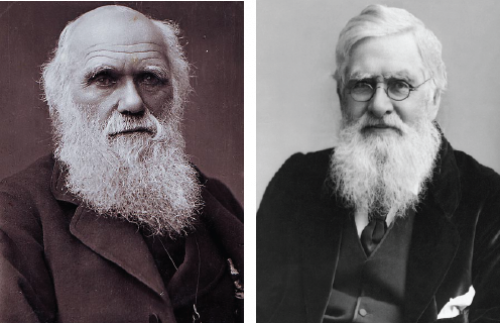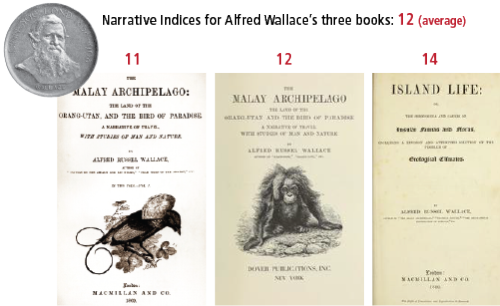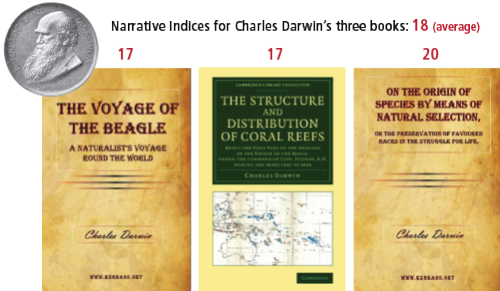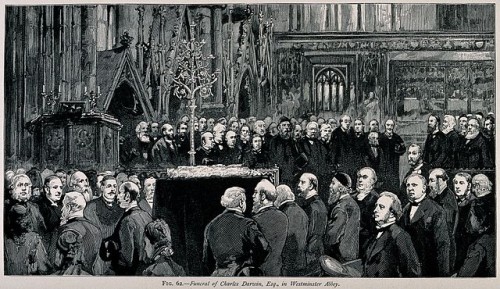Evolution’s hero vs. a historical footnote: A new Narrative Index sheds light on Darwin vs. Wallace
Bill Dennison ·Yesterday, Randy Olson announced his exciting new communication tool, the Narrative Index in his blog. For the past few months, Randy and I have been discussing this index, and we have been approaching the index from the perspective of an experimental scientist (a background that Randy and I share). Randy has been analyzing political speeches and I have been analyzing scientific papers. An initial investigation of Narrative Index in the science realm revolves around the co-discoverers of the Theory of Natural Selection. Both Charles Darwin and Alfred Wallace came up with the same theory at the same time, yet only Darwin is considered the father of evolution and Wallace is mostly relegated to a historical footnote. Why this discrepancy? Could Randy’s Narrative Index shed light on this mystery?

The Narrative Index has its origins in Randy Olson's recent book "Houston, We Have a Narrative". The Narrative Index is a deceptively simple but powerful way to assess the ability of these scientists and politicians to connect with their audiences. Randy has developed the ABT structure for delivering a message. ABT is shorthand for a sentence structured with ". . . and . . . but . . . therefore . . .", as I have described in a previous blog. Randy's Narrative Index is simply calculating the number of times the word "and" or "but" appears in the text. The word "therefore" is also counted, but since there are many alternatives to this word and it is not nearly as commonly used as "and" or "but", we have not used frequency of use in the calculation. The formula for the Narrative Index is the following: (# "but"s / # "and"s) x 100.
One of the enduring mysteries in ecology and evolution revolves around Alfred Russel Wallace and Charles Darwin. These two observant and thoughtful English naturalists independently conceived of the earth-shattering theory of natural selection. In fact, they simultaneously published their theory in 1858, yet Charles Darwin is widely known and Alfred Wallace is a historical footnote. We suspected that the Narrative Index had something to do with the fact that Darwin received so much acclaim and Wallace so little.

First, a thumbnail sketch of these two Victorian Englishmen will set the scene. Darwin was born first, on 9 February 1809, the 5th of 6 children into a fairly wealthy and respected family. Darwin was profoundly influenced by the writings of Thomas Malthus (An Essay on the Principle of Population), Charles Lyell (Principle of Geology) and Alexander von Humboldt (Kosmos). He made an extended field trip circumnavigating the globe aboard the HMS Beagle and spent considerable time in South America. Charles Darwin was a prolific author and published many books and papers over his career. Alfred Russel Wallace was born on 8 January 1823 to more modest means, and Alfred was the 7th of 9 children. Wallace was also profoundly influenced by the writings of Malthus, Lyell and Humboldt. He spent even more time than Darwin on extended field trips, with a 4-year stint in South America and 8 years in the Malay Archipelago (current day Indonesia). What made these naturalists so special were their keen observations of nature - they both collected numerous specimens, took copious field notes and thought about what it all meant when they observed variations in different species of plants and animals.

Wallace submitted a paper outlining his ideas on natural selection from his field camp on the island of Ternate in the Malay Archipelago to Charles Darwin who was residing in Down House, in Kent, England. Darwin received this letter on 18 June 1858 and was shocked to see that Wallace’s theory was identical to the theory that he had been developing. Darwin consulted with his colleagues and together they agreed to read Wallace’s paper at the upcoming Linnean Society meeting, accompanied by an extended abstract of Darwin’s unpublished manuscript, which would eventually become Darwin’s famous book On the Origin of Species. Darwin also published a letter he had written to Asa Gray, a Harvard University colleague, on 5 September 1857. The reason for publishing this letter was to establish Darwin’s primacy of the theory of natural selection. Neither Wallace nor Darwin were present when the letters were read at the Linnean Society meeting held on 1 July 1858, which were published two months later in the Journal of the Linnean Society (30 August 1858).
So this made for what can be considered a controlled experiment: the same theory, developed by two English naturalists who had the same influences, making similar field observations, and then communicating their results in the same journal at the exact same time. So we applied the Narrative Index analysis of Alfred Russel Wallace and Charles Darwin in their seminal 1858 simultaneous publication of the theory of natural selection in the Proceedings of the Linnean Society.

The results were striking. Wallace's letter had a Narrative Index = 12. Darwin had two entries, an extended abstract of his future book on the topic with a Narrative Index = 27 and the Asa Gray letter had a Narrative Index = 26. Since we view the Narrative Index of short publications as being too variable, we also assessed the Narrative Index of a larger body of work of these two prolific authors. For Wallace, we calculated the Narrative Indices of his books "The Malay Archipelago Volume 1" (11), The Malay Archipelago Volume 2" (12), and "Island Life" (14). For Darwin, we calculated the Narrative Indices of first three books "The Voyage of the Beagle" (17), "The Structure and Distribution of Coral Reefs" (17), and "Origin of Species" (20). The Narrative Index for Darwin (average = 18) was consistently higher than that for Alfred Wallace (average = 12) and we speculate that Darwin's writings were more compelling to read and this is why Darwin is buried in Westminster Abbey and is widely considered the father of evolution and Wallace is relegated to a footnote in history.

Wallace was actually a pallbearer at Darwin’s funeral and there is a medallion on the wall at Westminster Abbey near Darwin’s crypt with Wallace’s name and depiction. They became good colleagues and Wallace was always deferential to Darwin, partially due to Darwin being his senior by 14 years, but also due to Darwin’s higher social status. Future blog posts will cover the lives of these two extraordinary scientists, but this comparison of their ability to effectively communicate their theories serves to argue for a fundamental role that narrative has in communication. It provides some insight into what differentiated their relative roles in the history of science. Discussion with Randy Olson stimulated this analysis and interpretation, and Ben Wahle and Dylan Taillie, Science Communication interns at the
About the author
Bill Dennison

Dr. Bill Dennison is a Professor of Marine Science and Interim President at the University of Maryland Center for Environmental Science (UMCES).
Next Post > 4 ways sea level rise and climate change are reshaping the coast
Comments
-
Bill Nuttle 8 years ago
Not to pick too many nits, but act on your insight..."The Narrative Index for Darwin (average = 18) was consistently higher than that for Alfred Wallace (average = 12). *THEREFORE* we speculate that Darwin’s writings were more compelling to read and this is why Darwin is buried in Westminster Abbey and is widely considered the father of evolution *BUT* Wallace is relegated to a footnote in history."
-
Bill Dennison 8 years ago
You make good points. The reasoning behind the Narrative Index is based on Randy Olson's book "Houston, we have a narrative", and articulated in his recent blog posts that appeared the day before my blog. Darwin's social status and seniority undoubtedly contributed to his lasting reputation, but the differences in narrative index between Darwin and Wallace could also have a role. I enjoy reading Wallace's writings, but Darwin has some great passages as well. You are correct about Wallace having the opportunity to be buried in Westminster Abbey. My point is that visitors go to see the burial place of Darwin, Newton, etc. in Westminster Abbey because these historical figures are well known long after their death. I often ask for a show of hands from biology students who have heard of Darwin (everyone) v. Wallace (less than 10%). The "experiment" of the simultaneous publication by both Darwin and Wallace was similar to Randy's comparison of Stephen Douglas vs. Abraham Lincoln in their famous debates. Telling stories is more compelling and memorable when in the ...and...but...therefore... format, which is reflected in the Narrative Index.
-
Charles H. Smith 8 years ago
I assume I must be missing something here. Would you care to describe your reasoning why the numbers of 'ands' and 'buts' has any meaning in this context? At least, as compared to already-existing reputation, social status/privilege, etc., etc.? By the way, Wallace has always been considered a better writer than Darwin, and he got his writings into a lot more contexts than Darwin did. As to Westminster Abbey, Wallace turned down an offer to be buried next to Darwin there in favor of an attractive location near the coast. The main reason why Darwin gets most of the credit is "On the Origin of Species," which appeared before Wallace had a chance to put together anything substantial on the subject.